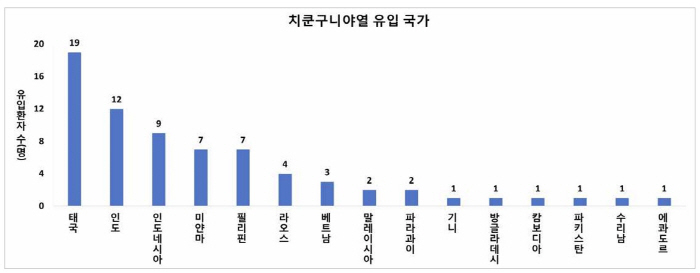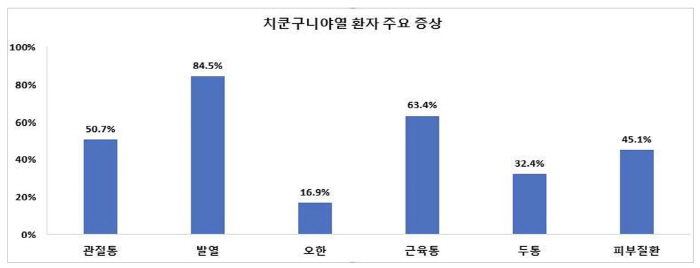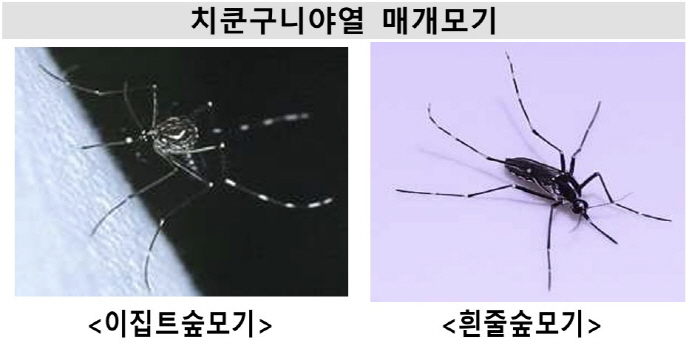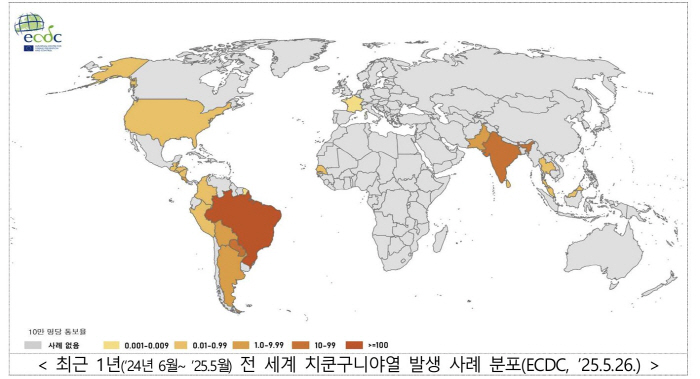The spread of the Indian Ocean and Guangdong Province What is the legal infectious disease Chikungunya fever…Forest Mosquito Watch
Jul 30, 2025
|
The Korea Centers for Disease Control and Prevention inspected the epidemic situation and response system presided over by the Korea Centers for Disease Control and Prevention to prepare for the recent influx of Chikungunya fever in Indian Ocean countries such as French Réunion and Mayotte and Guangdong Province, China.
|
|
A total of 71 people were reported from the first patient inflow in 2013 to July 25, 2025, all of which were infected after overseas visits and introduced into Korea. Men accounted for 57.8% (41), more than women's 42.2% (30), and people in their 20s and 50s accounted for 87.3%. In addition, Asia, the people's preferred destination, accounted for 93 percent of the estimated infected countries, and South America (Surinam, Ecuador, Paraguay), and Africa (Gini) were also identified.
|
The Korea Centers for Disease Control and Prevention conducted a risk assessment on the possibility of inflow into Korea and checked the response system by reflecting the current status of overseas Chikungunya fever. As a result of risk assessment considering the possibility of occurrence in Korea, the overall risk is low, but there is a possibility of potential exposure when infected patients are introduced overseas.
Although chikungunya fever is a different condition than dengue and Zika virus infections, it is currently responding to dengue fever and Zika virus infections as symptoms and major outbreaks are similar and spread by the same carrier mosquitoes. Since it was designated as a quarantine infectious disease in December 2023, it has been promoting patient monitoring, mosquito control, and prevention and promotion to the public and overseas travelers.
In addition, ▲In preparation for the possibility of the influx of Chikungunya, such as the recent increase in overseas travel, China (Guangdong Province), Indonesia, and the Philippines will be additionally designated as quarantine management areas to conduct intensive monitoring of inbound and outbound travelers, ▲ Strengthen the promotion of preventive rules for inbound and outbound travelers through various promotional media, and ▲ Additional monitoring points for mosquitoes flowing from overseas in public and port quarantine zones (36 existing → expanded 40).
On the other hand, he also emphasized the rules of conduct before, during, and after departure to prevent chikungunya fever. When planning an overseas trip for the summer vacation season, ▲ check the current status and precautions of infectious diseases in all countries of departure, and prepare ▲ mosquito repellents, mosquito nets, and bright long-colored clothes to prevent mosquito-borne infections such as Chikungunya fever, dengue fever, and Zika virus infections. In addition, be careful not to get bitten by mosquitoes by using ▲ mosquito repellent every 3 to 4 hours when you go out while traveling and wearing bright long-colored clothes. If you have symptoms such as fever, joint pain, and muscle pain upon entering the country, you should report only 13 airports to the quarantine officer at the National Quarantine Service through Q-CODE (or Health Quality Document), and visit a nearby medical institution for diagnostic tests and medical treatment. In addition, in order to prevent community transmission, even if symptoms occur within two weeks of returning home, you must visit a medical institution to inform your doctor of your overseas travel history and seek medical treatment.
Lim Seung-kwan, head of the Korea Centers for Disease Control and Prevention, said "As the habitat of Chikungunya fever-mediated mosquitoes is expanding due to climate change around the world, it is most important for overseas travelers not to be bitten by mosquitoes. Medical personnel should check their overseas travel history when conducting an interview with fever patients and actively diagnose Chikungunya fever, dengue fever, and Zika virus infections."
This article was translated by Naver AI translator.

















